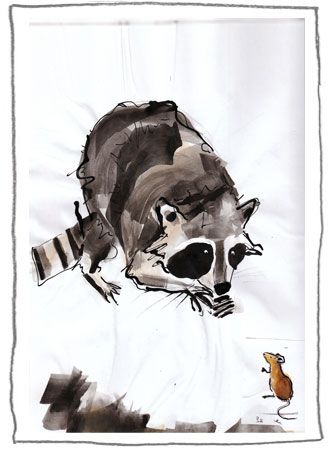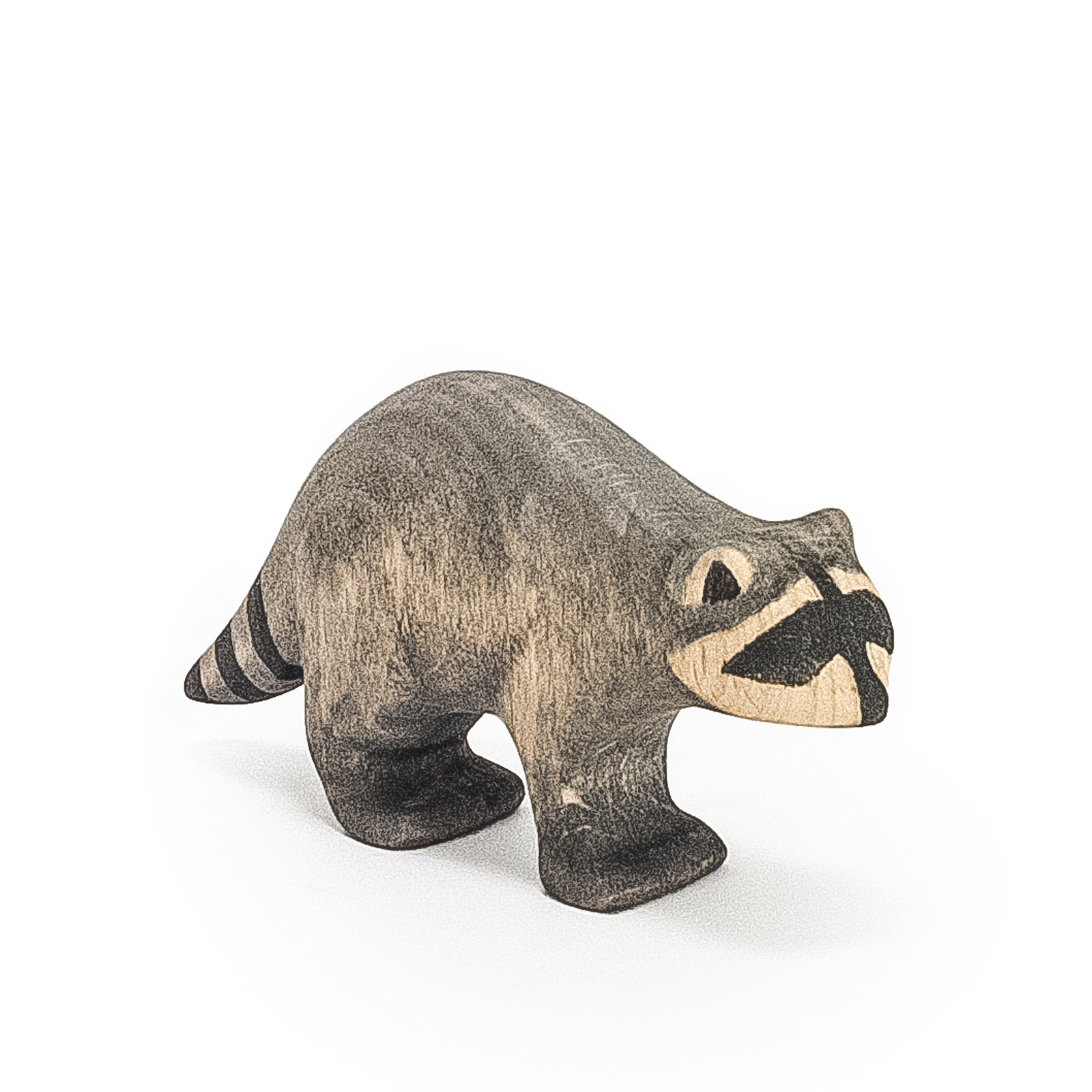Playing and learning with animal figurines
Children are naturally drawn to cute and cuddly animals, so a raccoon figurine has all the chances of becoming one of their favourite toys. Getting to know more about real raccoons and meeting their fictional counterparts, however, could help enrich their play, so raccoons will not be just beautiful collectibles but also actively played with toys that inspire more knowledge seeking, which, in turn, inspires more fascinating play.
Any random fact that impresses a child will be incorporated into their play so that a child makes sense of it and relates it to what they already know about the world. The facts we choose to introduce them to are manifestations of more general phenomena which constitute the world we live in. One of these is, for example, feeding to support life and how this need is satisfied in different ways by animals, plants and people. Another one is the need for protection from heat, cold, predators, hunters, etc.
As we have written before, learning about animals could open doors to knowledge of many other topics, such as ecology, geography, culture, art, etc. An animal does not live in isolation; it feeds on some species and, in turn, is fed upon by others; it shares its habitat with other species; it sometimes crosses paths with humans and in some cases becomes part of people’s culture – populating folk tales, myths and legends, art, literature and movies.
Branching out and moving on to other topics is an organic and interesting way to learn; it is also meaningful and efficient as it most often follows a child’s interest, and it expands and enriches a child’s interest.
How do you start? How do you go about it?
You do not have to be an expert on raccoons to fascinate children and give them food for play and further exploration. You can start with the most obvious.
How do you know an animal is a raccoon? You first recognize it by the black bandit’s mask it wears. Did you know that it helped a raccoon improve its night vision by reducing glare? The mask makes it look mischievous, and in fact, you will find out that it is if you try to raise it as a pet. It is so curious that it would unscrew jar caps and unlock intricate locks. How come some animals have been domesticated while others are so hard or impossible to tame?
A raccoon is smarter than a fox, and has a strong memory to help it remember what it has learned by solving a problem. Here is why it has entered Native American mythology both as a trickster and a sage. Some people have even adopted it as their clan animal. Here is a link to a page where you can read several Native American tales about the raccoon.
While most of us perceive raccoons as emblematic of North America, some scientists say that the first known animals of this family lived in Europe millions of years ago. If they originated there, then how did they spread out to reach America? We have not figured out yet, but what we know for sure is that the question can lead us to other important questions, such as how animals migrate, what happens when an alien species is released in an environment, how sometimes it could be beneficial, but sometimes it might seriously affect the local ecosystems and the local economy. Japan is one of the sad examples – raccoons have endangered its agriculture, native species and historical architecture. Here is a small part of a PBS documentary.
Nowadays there are many raccoons in some places in Europe and Asia as people wanted to enrich their wildlife by introducing them or failed to keep some of them in captivity. As raccoons are very adaptable animals, they have found ways to live in many different wild and urban environments. It might be interesting to explore how their lives have changed because of that – what new sources of food they have found, and what new dangers and challenges they are facing.
You do not need to search high and low to find the most important information about raccoons and do not need to spend too much time sifting through it to pick what might be interesting and useful to share with your children. Wikipedia is a free source, just a click away. It is not written in a little child-friendly style and format, so it is not a good idea to directly read from it. Just jot down the most important facts and you have good topics for conversation with your child later.
Younger children are interested in what animals eat, who might eat them, where they hide, if they climb trees, swim or fly. As they grow older, they will be interested in how they are adapted to their environment, how their lives change with the seasons, how they take care of their young, if and how they interact with people. The interaction with people topic can lead to exploration of people’s material and immaterial culture and open children’s eyes to the fact that people might have similar needs which they satisfy in different ways, that sometimes what other people find important might be different from what is important to themselves, etc.
A topic which is not so often explored but might be interesting to older children is biological taxonomy, how species are related and similar to one another.
Here are some facts about raccoons that you might wish to relate to your children:
You might show them an informative picture on Wikipedia, showing how raccoons are related to weasels, skunks, red pandas, seals, bears and dogs. They might try to find similarities and differences between them.
You might teach your children about what raccoons eat and thus introduce them to the concept of herbivores, carnivores and omnivores, as well as seasonal food sources. In spring and early summer raccoons would eat mostly insects and worms (unlike us, humans, they are capable of hearing the movements of worms underground). However, they prefer fruits and nuts, such as acorns and walnuts, which they can find in late summer and autumn. These help them build up fat they will need in winter. Sometimes they prey on other animals, but they are not good hunters, so they prefer what is easiest to catch – fish, amphibians, eggs and hatchlings. By eating eggs and very young birds or reptiles, they can seriously endanger other species, for example turtles. When raccoons live near people’s settlements they would eat not only leftover food but also steal pet food, corn from the fields and fruit from orchards, kill chicken and ducks, eat their eggs.
In turn, raccoons are threatened by some predators – coyotes, foxes, wolves, bobcats, cougars, owls, hawks, eagles and even alligators. When attacked, raccoons would bravely fight back, scratching and biting, but they are smaller and weaker, so their best defense is escape. As they are slow and clumsy runners, they would prefer to climb a tree or plunge into water. They are excellent swimmers and climbers. Most predators do not like water, so they will leave raccoons alone.
Here is why bodies of water and trees are so important to raccoons. In the past raccoons naturally lived along rivers and in woodlands. Trees are used as resting places, and they might also house some of their dens. Raccoons build their dens in hollow logs and trees, under rocks and brush piles, and sometimes even use burrows dug by other animals. When they live in human settlements, they use attics, chimneys, abandoned houses and vehicles. Sometimes they make their dens under homes or wood piles. These are the places where they hide during the day as they go out to look for food at night.
In colder places they take winter rest, but unlike truly hibernating animals, they do not really sleep through the whole winter. They sometimes go out of their dens to bask in the sun on warmer days or look for something to eat. Their thick underfur protects them from winter cold, while their long upper hairs protect them from wind and rain.
Raccoon babies (“kits” / “cubs”) spend their first weeks in the den, while slowly gaining weight and opening their eyes and ears to see and hear the world. Later their mom takes them out on training tours to teach them how to procure food on their own. In the autumn they will be grown ups who should live on their own. As babies they are vulnerable to losing their mother and to starvation. Many of them will die during their first year.
Other important death causes are hunting and vehicles, but the most frequent cause of death are diseases, which sometimes might reach epidemic proportions. Rabies is a disease which can affect people and domestic animals, so authorities in some countries try to vaccinate raccoons. They find it much more efficient to give them oral vaccines through morsels of food (usually sugar and fat) rather than catch them and give them injections.
If your children are interested in farming, the topic of keeping raccoons away from human settlements might be a fascinating topic. Some websites on farming might provide information.
As raccoons are popular as game animals, some children might be interested in raccoon hunting, while others might be interested in how raccoons escape hunters. Raccoons know how to throw hunters and their dogs off their scent. They hide into streams to wash their scent and then return to land. They hop on branches to break scent trails and then hop back to the ground.
Raccoons in mythology, art, and literature

As we have already mentioned, raccoons are featured in Native American legends, and you can easily find and read some folk stories online. Wikipedia gives some information about their representation in petroglyphs and sculptures.
One of the most popular books about raccoons is a memoir novel about a pet raccoon. We believe that it might be of interest to children 9+. The novel by Sterling North – Rascal, and it is about a boy who lost his mom and was raised by his father. It takes the reader back to the times when children were free to roam the outdoors on their own, and one of them was even allowed to build a canoe in the living room. Here is a link to the plot, and another one to many reviews. Here is a link to part of the audiobook. This is the book on which a Japanese animated series was based – the one that inspired so many Japanese families to take raccoons as pets and then release them in the wild when they discovered they cannot handle them. As we have already mentioned, Japan is still paying the cost of the devastation raccoons caused.
If you are interested in finding picture books for younger children, you can surely find a lot as raccoons seem to make popular book characters.
We hope you enjoyed reading this text and found it useful. For more articles on how animal toys can be useful and fascinating, check our earlier texts in the blog and follow it as we are planning to add many more articles on toys, play and animals. If you are seriously interested in these topics, you can start with the general article on toy animals and then move on to ones about specific animals and how you can enrich your children’s play with them.
